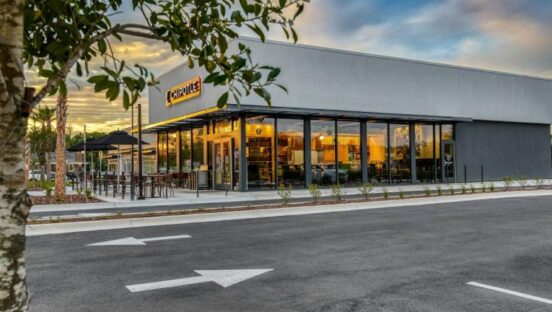








In photo above: Siblings Andrew, Irene, and Margaret Li (from left) opened Mei Mei, a Boston-based fast casual, in 2013.
Ready for launch
In 2014, Sahil Rahman and his childhood friend Rahul Vinod quit their jobs in New York City, moved back in with their parents, and started working on a plan to open their own restaurant. Three years later, in December 2017, they opened RASA, an Indian fast casual in Washington, D.C., that has been so well received it’s outperforming national chains in its Navy Yard neighborhood.
But in those early years, the two millennial entrepreneurs quickly burned through their savings and were forced to take part-time jobs just to make ends meet. Opening a new restaurant—particularly one started from scratch—is a challenge so great that many fail at it. Some manage to open only to falter and close their doors within a year, while others don’t even make it to that point. A few make it over the multiple hurdles and achieve their dreams, and none of it comes easily. Here’s a step-by-step look at the store-opening process, with tips from several entrepreneurs who recently made their dreams a reality.
Business plan
Rahman and Vinod started off with a business plan to show to prospective investors.
“This included the challenges customers faced in the market, the opportunity to solve them, and how we planned on doing so,” Rahman says. “It also went into detail on the financials of the deal.”
Sofia Deleon is the owner of El Merkury, a Guatemalan street food fast casual in Philadelphia. She spent about six months writing her business plan, which contained the vision and mission, the menu, and the ideal customer experience. It also detailed estimated finances, the amount of money needed to get started, how much she expected to make, a marketing plan, and information about her background and the concept. To make things easier, she used an online template and personalized it.
Deleon also turned to her former professors at St. Joseph’s University for advice, as well as other business owners she sometimes cold-called. “They helped with relationships mostly, and relationships are more important than I thought,” she says.
“It’s all about who you know and who you meet.”
Financing
Financing is the biggest hurdle for anyone opening a restaurant. Without capital to fund the space, the employees, the goods, and everything else, an idea remains just that.
Rahman and Vinod decided to seek investors for RASA and chose a model where they would pay back their investment plus a percentage of profits for the life of the restaurant.
But finding investors was “incredibly difficult,” Rahman says. Friends and family invested about 20 percent of the capital, and the business partners found that they were raising cash in smaller increments than they would have liked.
“It was literally speaking to everyone we knew, going to every event where we thought there would be entrepreneurs, high-net-worth folks, and potential investors,” Rahman says. “We put together a strong pitch deck and a strong business case, and had to make people believe in an idea that did not yet exist. It was a gruesome process.” All told, it took six months to raise sufficient money for RASA.
Raising money can feel like a chicken-or-the-egg process. Just look at the case of Louis Maskin, who is planning to open fine-casual Greek concept Xenia All Day with two partners in Los Angeles in early 2020. “People said our concept sounded great, but to come back when we had an economic model that had been proven,” he says. “Investors want something tangible, but we couldn’t make any promises.”
So far, friends, family, and past colleagues have been behind Xenia’s investments. Maskin has found it’s been easier to get local people to invest “because they want to buy into something they can experience.”
Site selection
With money in the bank (or at least promised), restaurant entrepreneurs have to find a great location for their future restaurant—one that is both affordable and also gets the concept in front of a demographic who can make the brand thrive.
Maskin and his partners decided on the Westwood area of Los Angeles because it’s near the UCLA campus, “so it has a rotating selection of youth and the demographics are incredible.”
There is a great potential clientele within both a one-mile walking radius and a five-mile delivery radius, he adds. Now, he’s looking for a former restaurant spot so it has the right electrical and ventilation needs. An existing restaurant build-out also means permitting is faster, Maskin says.
It took Deleon about a year to find a location in Philadelphia, but her patience in waiting for a former restaurant to become available paid off. “It drastically saved us in investment costs,” she says. The space was larger than she’d anticipated, but it was near the center of Philadelphia and she knew it could allow her to grow her already thriving catering business.
Competition was fierce downtown, she says, but she had an ace up her sleeve. “El Merkury’s concept of Central American street food and churros was distinct enough to stand out from the other fast casuals in the area,” she says.
When the perfect site is located, operators must enter into lease negotiations and create a letter of intent, in which the owners and landlords hash out what will and won’t happen in the space. This includes the rent, triple net (real estate taxes, building insurance, and maintenance), and tenant improvement allowance.
“It’s very frustrating,” Rahman says of the process. During the negotiations, he started working with the architect since he and Vinod had decided to outfit the restaurant from scratch. “It’s a tricky balance because if … the lease doesn’t come through, it’s wasted money,” he says. He only released the architects to begin working “when we were at a point when we felt we could really move forward.”
Once the lease was signed, Rahman and Vinod had to get the proper permitting, which, in a large city like Washington, D.C., can be protracted; it took four months just to get approval to begin construction, Rahman says. He worked on branding, marketing, and the menu throughout this time period.
Construction and design
Matt DeBusk worked with Smith Hanes Studio, the best local architectural firm he could find, to build Austin’s Burritos in Dacula, Georgia.
“They work exclusively with high-end, chef-driven restaurant brands, and I begged Smith to work with me,” he says. “He said he didn’t do restaurants like mine, but he realized I could build the brand at the level that was worthy of his team’s resources, so he built it.”
DeBusk wanted everything custom-made for Austin’s Burritos, but also needed an initial interior design that featured easily sourced materials and simple replication for future locations.
For equipment, he worked with a professional restaurant kitchen design consultant, who helped with minimizing wasted movement and gauging the refrigeration space off the expected sales.
RASA’s design is distinct. Guests enter through enormous blue doors, and the interior has touches that are both modern and authentically Indian, with swing chairs and trinket boxes on the wall that create a mandala design. Rahman says he wanted to be as inclusive as possible with RASA’s interior design while also creating something “funky and fun.”
He and Vinod wanted the restaurant to look American enough to draw in people unfamiliar with India and Indian food, but simultaneously look interesting to people more aware of that culture.
The menu
The food is the axis of a restaurant and has to be top-notch from day one.
Rahman and Vinod knew that Indian food is not very familiar to most Americans, so they used a familiar model to serve it (fast casual with an open kitchen, “which takes away some mystery,” Rahman says) and familiar ingredients.
They also named their dishes with a more American bent; for example, sautéed spinach and charred eggplant are called exactly that, rather than the traditional saag and baingan. “It’s more approachable,” Rahman says.
Deleon also wanted her food to be accessible, so she added user-friendly descriptions on her ordering kiosks; her pupusas are described as a “dumpling with a savory filling.” She also made some changes to the recipes, so even though the food is not 100 percent authentic, it is more appealing to American diners. For example, she toned down the spice, and to appeal to Americans with allergies, she uses no gluten and has dairy- and meat-free dishes available, too.
Irene Li uncovered a lot about menus before she opened Mei Mei, a Chinese fast casual she runs with siblings Andrew and Margaret. Previously, Li ran a food truck where she changed the menus often to match recipes cooked with local, easily available ingredients.
“We had more free rein, so we could test things. We could also change the menu a lot more because we weren’t feeding as many people,” she says.
Of course, a menu can’t shine without strong ingredients. Li works with companies that care about sustainability and that treat customers and animals humanely. When she was operating the truck, she researched a lot of nearby farms and then visited them. She also talked to chefs about who they worked with.
Deleon found a supplier that imported Central American foods for her more esoteric items; the rest were similar enough to Mexican ingredients that she had no trouble sourcing from standard suppliers.
DeBusk interviewed every foodservice provider in his market and ended up with one that he says was committed to his long-term success.
“We needed a partner to help us navigate the endless sourcing options,” he says.
Branding
The right name can make or break a restaurant. Rahman and Vinod wanted something easy to pronounce. Maskin says “naming was the thing that, outside of financing, took the most time and money.”
He and his partners at Xenia sought a name that resonated with the three of them; that they could create a meaningful brand around; that worked with social media and had hashtags, email addresses, website, and other digital components available; and that was trademarkable. That process cost $12,000–$15,000, he says.
Deleon opted to use corn for her logo, since it’s the central pillar of Guatemalan food. “Your brand is everything, and I wanted people to see the corn and immediately think of El Merkury,” she says. Her logo is everywhere, she says, “from the entrance sign to the tables that have it sprayed on their edges. We stamp it on bags and it’s on staff uniforms. We use logo stickers on every tray and bowl, as well on printed catering menus. I even have it tattooed on my arm.”
DeBusk named Austin’s Burritos for his love of Austin, Texas, and to get to know his brand, he asked himself: What does the food taste like? What does the restaurant feel like? How do I feel when I’m here? What does the music sound like?
“I was transported to my time in Austin, where they have that phenomenal balance of modern approaches blended with traditional,” he says. “That’s what I wanted to re-create and drop into Atlanta.” He discovered the name and the domain were available, so he came up with a logo and trademarked both.
Hiring
Finding good labor these days is tough for any restaurant, let alone for a new concept.
“It was hard to find people who understood our mission and purpose and the type of food we served,” Deleon says. At first, some staff came on board full-time from pop-ups she’d held in office buildings the year prior, she says, “and they worked well because they understood the mission and background.”
Most of Li’s staff have come to her through word of mouth and friends and family, she says. “Most of our staff are pretty highly educated, and I think they come to work here because they believe in the values and are interested in business.”
The RASA team initially used Harri for hiring, but the staff has since grown via friends of employees, or “folks who have walked into the door looking for an opportunity,” Rahman says.
DeBusk didn’t take hiring lightly and interviewed more than 200 people to find his initial 20 team members. And he made clear to them that if hired, they would be a part of a team pushing the restaurant in the same direction versus just showing up to a job—a common goal that really appealed to them, he says.
Marketing
Marketing a new restaurant can take many different forms. Deleon received positive word-of-mouth marketing through her pop-ups and was fortunate to have a local editor follow the restaurant on Instagram from day one. He wrote an article about El Merkury before it opened. More local press came after the opening, and winning the Best of Philly award for best fast-casual concept in the city also “gave us more local credibility,” she says.
For DeBusk, marketing was grassroots. “The four weeks leading up to our opening, I visited every local business in the area to introduce our new restaurant,” he says. “The face-to-face invitation to come try us out generated massive interest.”
He also established relationships with the local schools and churches, which have helped connect the restaurant to the local community. “We tried some traditional advertising, but nothing was as powerful as getting outside the restaurant on a regular basis and personally inviting people to dine with us or consider Austin’s for their next catered event,” he says.












